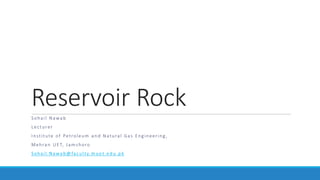
Reservoir rock
- 2. Reservoir A reservoir is a subsurface volume of porous and permeable rock that has both storage capacity and the ability to allow fluids to flow through it.
- 3. Fluid distribution in a reservoir rock As hydrocarbons and water accumulate in a reservoir, vertical separation occurs as a result of the difference in the specific gravity of the various fluids. Typically, the Lighter fluids, like gas, rise to the top of the reservoir. Below the lighter fluids is a gas to oil transition zone. This transition zone is a relatively thin zone above the oil accumulation.
- 4. Physical characteristics of reservoirs Physical characteristics of a reservoir include original deposition and subsequent changes, 1. Depth 2. Area 3. Thickness 4. Porosity 5. Permeability 6. Wettability 7. Capillary pressure 8. The type of reservoir
- 5. 1. Depth The physical characteristics of a reservoir are greatly affected by the depth at which they occur. Shallow reservoir: Created by the folding of relatively thick, moderately compacted reservoir rock with accumulation under an anticline or some trap. The hydrocarbons would generally be better separated as a result of lower internal reservoir pressures, less gas in solution and oil of increased viscosity, resulting from lower temperatures. Deep reservoir: Typically created by severe faulting. The hydrocarbons would be less separated with more gas in solution and oil of reduced viscosity because of higher temperatures. There is often a reduction in porosity and permeability due to increased compaction.
- 6. 2. Area and thickness The total area of a reservoir and its thickness are of considerable importance in determining if a reservoir is a commercial one or not. The greater the area and thickness of the reservoir, the greater the potential for large accumulations of oil and gas.
- 7. 3. Porosity Porosity is the ratio of void space in a rock to the total volume of rock, and reflects the fluid storage capacity of the reservoir. It is usually denoted by φ.
- 8. 4. Permeability The ability of a rock to transmit fluid through porous media is termed as its permeability. Permeability is measured in darcies. Few rocks have a permeability of 1 darcy, therefore permeability is usually expressed in millidarcies or 1/1000 of a darcy. Poor…………………. 1-10 mD Fair………………. 10-100 mD Good …………100-1000 mD Excellent ……….>1000 mD
- 9. 5. Wettability If a rock contains both water and oil, typically the water will occur as a film adhering to the rock grains with the oil occupying the space between, Such a reservoir is said to be water-wet, because water is the fluid phase that is “wetting” the grains of the rock. In some instances, although rarer the chemistry of the oil may be such that it is the fluid that is in contact with the grains of the rock. This type of reservoir is said to be oil-wet.
- 10. 6. Capillary Pressure Reservoir rocks are composed of varying sizes of grains, pores, and capillaries (channels between grains which connect pores together, sometimes called pore throats). As the size of the pores and channels decrease, the tension of fluids in the rock increases. When there are several fluids in the rock, each fluid has a different surface tension and adhesion that causes a pressure variation between those fluids. This pressure is called capillary pressure.
- 11. 7. Types of Reservoir Sandstone Reservoirs Carbonate Reservoirs
- 12. Sandstone Reservoirs Sandstones are generally created by the accumulation of large amounts of clastic sediments which is characteristic of depositional environments such as river channels, deltas, beaches, lakes and submarine fans. Sandstone reservoirs have a depositional porosity and permeability controlled by grain size, sorting, and packing of the particular sediments. Diagenetic changes may include precipitation of clay minerals in the pore space, occlusion of pores by mineral cements, or even creation of additional pores by dissolution of some sediment.
- 13. Sandstone Porosities Sandstone reservoirs have porosities of 15 – 30%. Mainly Grain size is almost always the control the primary porosity. Secondary porosities in sandstones aided the primary porosity.
- 14. Effect of clay mineral distribution in sandstones Clean sand and structural clay don’t affect the porosity, laminar clay affect both porosity and grains while Dispersed clay effects the porosity mostthus we only discussed Dispersed clay. EXCLUDED FOR MID EXAM
- 15. Types of dispersed clay in sandstone reservoirs 1) Discrete particle (kaolinite) 2) Pore lining (chlorite) 3) Pore bridging (illite) EXCLUDED FOR MID EXAM
- 16. 1) Discrete particle (kaolinite) Kaolimiteacts as discrete partials and mainly reduces porosity of the reservoir. EXCLUDED FOR MID EXAM
- 17. 2) Pore lining (chlorite) Chlorite makes a lining in the pores of reservoirs and reduces porosity. EXCLUDED FOR MID EXAM
- 18. 3) Pore bridging (illite) Illite makes bridges within the pores of reservoir and it is as bad as it gets for permeability reduction. EXCLUDED FOR MID EXAM
- 19. Carbonate Reservoirs Carbonate reservoirs are created in marine sedimentary environments with little or no clastic material input and generally in a location between 30° north and south of the equator. Porosity types of carbonate reservoirs include vuggy (pores larger than grains), intergranular (between grains), intragranular or cellular (within grains), and chalky. Diagenetic changes such as dolomitization, fracturing, dissolution, and recrystalization (rare) are extremely important because they have the ability to create very effective secondary porosity. Cementation, another type of diagenesis, generally reduces porosity and permeability.
- 20. CarbonatePorosities: Most carbonate reservoirs have primary porosity of about 5 – 15%, but secondary porosity could be much more greater thus in carbonate porosities which allows hydrocarbon production tend to be mostly secondary. Carbonate pores are called as naughty pores because they are relatively difficult to deal with and measure like microporosity, vugs and fractures.